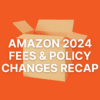
Prime Day 2025 is approaching soon—the big summer sale is happening in approximately two months, and brands need to start preparing in order to ensure accurate inventory levels, enact optimized advertising strategies, and reach your sales goals despite uncertainties.
The team at Kapoq has compiled everything you need to know about Prime Day 2025—when the sale will take place, how long it’ll last, deadlines you need to meet, and our best strategies to prepare.
When Will Prime Day be in 2025?
Amazon has confirmed Prime Day will be happening sometime in July 2025. While we don’t know the exact dates, the sale will probably happen the second week of July, which is when it’s been in the past.
Mark your calendars for July 8-11th, but don’t be surprised if it actually falls on July 15-18, at least until we receive final confirmation from Amazon themselves.
Things to Know
Early Deadlines
As usual, there are certain early deadlines to be aware of when it comes to Prime Day.
Your deals for Prime-Exclusive Best Deals and Lightning Deals for Prime Day need to be scheduled by May 23, 2025.
For inventory, you have a little more time to get your Prime Day products ready. Your FBA shipments with “minimal shipment splits” need to arrive at an Amazon facility by June 9, 2025. Your FBA shipments with “Amazon-optimized shipment splits” need to arrive by June 18, 2025.
Length of Sale
This year, Prime Day will be four days instead of two days, like in the past. This marks a big change in the event, and there could be implications for this in your advertising strategy, inventory preparation, and total sales, which we’ll get into later.
Our Predictions
Broader Market Implications
One thing on everyone’s mind this Prime Day is how the latest tariffs will impact sales. Overall, this could mean that Prime Day is smaller than usual, especially given the fact that Prime Day 2024 was Amazon’s biggest sales event ever.
There are a few main implications of the recent tariffs affecting US brands importing from other countries. Most brands and consumers are primarily concerned with price increases. Price increases may be coming soon on a whole range of products, especially those imported from China which have the highest tariffs (previously 145%, now ~30% depending on the product, as of publication date).
In addition, many sellers who were subject to tariffs, especially if they manufacture in China, had been delaying shipments or orders while they waited for promising tariff news. This means inventory might not arrive in the US in time for Prime Day, which would significantly lower your sales.
Even for brands that didn’t completely stop manufacturing, this 90-day pause in the tariffs is likely to cause a run on the ships and containers that bring inventory to the US. Delivery times and costs are expected to rapidly increase, reminiscent of the COVID era, all right around the time you need to get the inventory to FBA.
If your brand is exempt from tariffs for whatever reason, you could see a noticeable bump in your sales, as customers turn their focus to brands that are well-stocked and avoid price increases.
Performance
Along those same lines, your brand’s performance could be impacted—positively or negatively—by tariffs, the four-day length, or your advertising strategy. Offering different deals, such as Lightning Deals, across different days could boost sales.
Pay special attention to what your competitors are doing right now. Those with inventory or supply chain issues are likely pulling back on ad spend, possibly raising prices, and taking other conservative measures. This could open opportunities for your brand to step up and take market share!
Our Tips to Prepare
Rethink Advertising
Since Prime Day will extend four days, you should rethink your advertising strategy in light of that fact, as well as the tariffs. Since the sale is longer, you might need to spread your budget out across four days instead of two, which could impact how much you’re willing to discount during the sale.
Or, maybe you’ll prioritize the first two days, allocating your budget primarily for those days. According to Momentum Commerce, in 2024, Prime Day 1 was larger than Day 2, but not by much: “Median day 2 sales in 2024 were 83.9% of the day 1 figure – in 2023, that number was only 70.3%.” So, while Prime Day 1 is still generally bigger, Day 2 isn’t far behind.
Accurate demand planning is paramount here to ensure you have enough inventory!
Consider Dayparting
Especially since Prime Day will be four days this year, consider implementing dayparting. Not only can dayparting help you allocate your budget during high-traffic times, but it can also allow you to avoid wasted spend during non-peak hours.
Bird Rock Brands utilizes Kapoq’s automated dayparting during non-tentpole days, and their ads perform better than with manual dayparting. However, they adopt manual dayparting during sales events like Prime Day and Cyber Weekend. This functionality and ease of use allows you to control your advertising efforts while also setting-it-and-forgetting-it when needed.
Plan Prime Day with Ease with Kapoq. Sign up for your free demo today.







